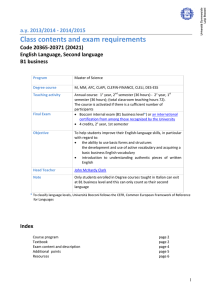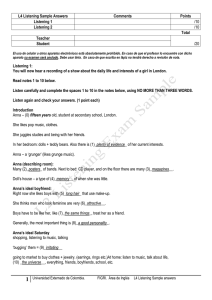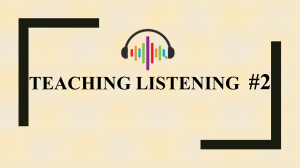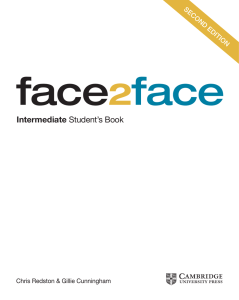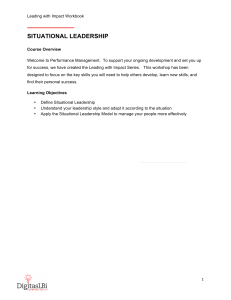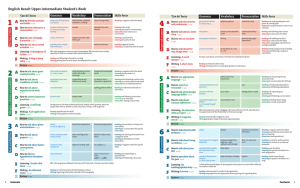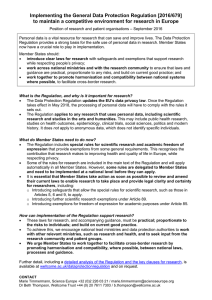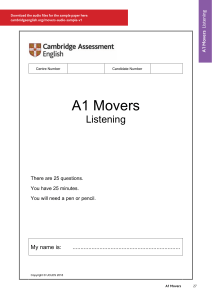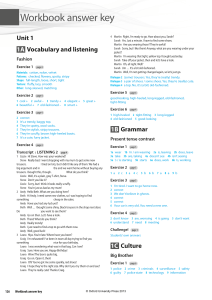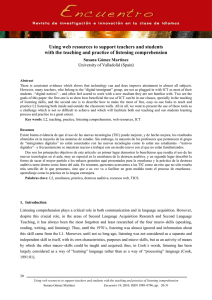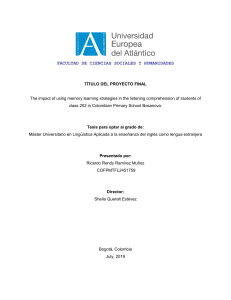Class contents and exam requirements
Anuncio
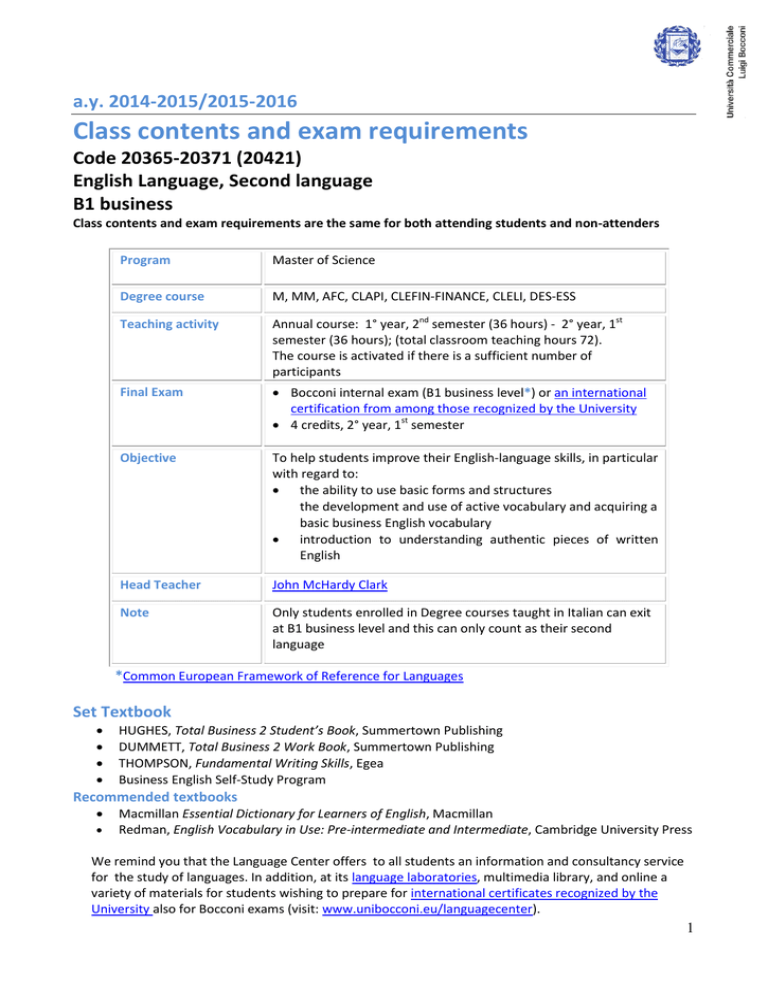
a.y. 2014-2015/2015-2016 Class contents and exam requirements Code 20365-20371 (20421) English Language, Second language B1 business Class contents and exam requirements are the same for both attending students and non-attenders Program Master of Science Degree course M, MM, AFC, CLAPI, CLEFIN-FINANCE, CLELI, DES-ESS Teaching activity Annual course: 1° year, 2nd semester (36 hours) - 2° year, 1st semester (36 hours); (total classroom teaching hours 72). The course is activated if there is a sufficient number of participants Final Exam Bocconi internal exam (B1 business level*) or an international certification from among those recognized by the University 4 credits, 2° year, 1st semester Objective To help students improve their English-language skills, in particular with regard to: the ability to use basic forms and structures the development and use of active vocabulary and acquiring a basic business English vocabulary introduction to understanding authentic pieces of written English Head Teacher John McHardy Clark Note Only students enrolled in Degree courses taught in Italian can exit at B1 business level and this can only count as their second language *Common European Framework of Reference for Languages Set Textbook HUGHES, Total Business 2 Student’s Book, Summertown Publishing DUMMETT, Total Business 2 Work Book, Summertown Publishing THOMPSON, Fundamental Writing Skills, Egea Business English Self-Study Program Recommended textbooks Macmillan Essential Dictionary for Learners of English, Macmillan Redman, English Vocabulary in Use: Pre-intermediate and Intermediate, Cambridge University Press We remind you that the Language Center offers to all students an information and consultancy service for the study of languages. In addition, at its language laboratories, multimedia library, and online a variety of materials for students wishing to prepare for international certificates recognized by the University also for Bocconi exams (visit: www.unibocconi.eu/languagecenter). 1 Resources Materials prepared by professors Self-study programme Past exams Extra teaching materials Language tutors Office Hours for Bocconi teachers International certificates recognized Course program Objectives At the end of the course, the student should be able to: use basic forms and structures to communicate without undue difficulty in given situations and about familiar subjects understand and use the most common words understand and use the basic business English terminology read and understand brief authentic written pieces (length approx. 750 words) Contents The teaching will consist of the following activities: grammatical revision: developing correct forms and structures vocabulary extension: reading authentic texts from books, newspapers and internet written assignments: individual topics or working in small groups, presenting work to the class, writing formal letters, memos, e-mails and other work-related tasks reading comprehension: analysis and presentation in class of passages selected by the teacher oral interaction: discussing day-to-day issues or work-related topics mock exams and testing: practice using past papers Self-study Activities & Skills Learning a language and effective preparation for the exam require regular attendance of lessons and constant effort also in terms of autonomous study. For this purpose, a series of activities to be done in the textbook (see adopted texts). In the Libraries students can also find the material provided by the teacher in the classroom and some previous exam papers. It is suggested to dedicate 3-5 hours weekly for independent study. Organisation Skills Subjects Grammar Activities Ways of Working Present Tenses Vocabulary: Different ways of working Reading Skills Listening Skills Writing Skills Speaking Skills Students Book Unit 1 Workbook Unit 1 Thompson, Unit 1 2 Vocabulary: Benefits and Incentives Reading Skills Listening Skills Writing Skills Speaking Skills Vocabulary: Types of Business Reading Skills Listening Skills Writing Skills Speaking Skills Vocabulary: Types of Advertising Reading Skills Listening Skills Writing Skills Speaking Skills Vocabulary: Verb Collocations Reading Skills Listening Skills Writing Skills Speaking Skills Vocabulary: Hiring & Firing Reading Skills Listening Skills Writing Skills Speaking Skills Vocabulary: Describing Jobs Reading Skills Listening Skills Writing Skills Speaking Skills Vocabulary: Linking Phrases Reading Skills Listening Skills Writing Skills Speaking Skills Vocabulary: Telephone Words Reading Skills Listening Skills Writing Skills Speaking Skills Vocabulary: Verb + Noun Combinations Reading Skills Listening Skills Writing Skills Speaking Skills Vocabulary: Financial & Trade Terms Reading Skills Listening Skills Writing Skills Speaking Skills Vocabulary: Legal Terms Reading Skills Company benefits The Past Students Book Unit 2 Workbook Unit 2 Thompson, Units 2 & 10 Starting a Business will and the future Students Book Unit 3 Workbook Unit 3 Thompson, Unit 8 Advertising Modals Students Book Unit 4 Workbook Unit 4 Thompson, Unit 11 The Workplace Reporting Students Book Unit 5 Workbook Unit 5 Thompson, Unit 13 Recruitment Passives Students Book Unit 6 Workbook Unit 6 Thompson, Unit 9 Sales Comparatives & Superlatives Students Book Unit 7 Workbook Unit 7 Thompson, Unit 3 Training -ing forms and infinitive Students Book Unit 8 Workbook Unit 8 Thompson, Units 4 & 15 Branding Relative Clauses Students Book Unit 9 Workbook Unit 9 Thompson, Unit 12 Price Management Conditionals Students Book Unit 10 Workbook Unit 10 Thompson, Units 6 & 14 Ethical Economics Articles Students Book Unit 11 Workbook Unit 11 Thompson, Units 5 & 7 Business Law Indirect Questions and Students Book Unit 12 Workbook Unit 12 3 tags Listening Skills Writing Skills Speaking Skills Thompson, Appendix 1 Exam content and description Objectives The exam is scored out of a maximum of 30 points, which will go into the calculation of your grade point average, and evaluates your ability to: understand fairly long and complex listening passages, making notes and reworking the information heard write structured texts of various types according to instructions oral interaction: presentation and discussion demonstrate your knowledge of the language, by correctly using a range of vocabulary and grammatical structures Rules The exam consists of a written paper and an oral exam. Both need to be passed for the grade to count towards the final average. In order to take the oral exam, it is necessary to: pass the written exam (minimum mark 18/30) have a test score that hasn’t expired, i.e. that is still valid (see Written Exam, Validity) Students can choose to retake the written exam before taking the oral exam but must remember that handing in their paper annuls any previous grade given. Students must enroll for all exams via the Punto Blu. The Oral exam is compulsory and the score is added to the written grade. Organisation Written Exam The written exam consists of three parts. Each part is assigned a mark out of ten and the sum of these marks is converted into thirtieths to give the final grade 10/30 First part Listening Check candidates' ability to understand the topic, language and opinion expressed in a brief Objective listening passage Skill Listening to messages, announcements, surveys, radio broadcasts Test Second part Objective Skill Sentence and/or table completion, true/false questions, multiple choice answers Test Third part Objective Skill Test Duration Dictionary Use of Language 10/30 Checking that students can use the main forms and structures with reasonable ease Identifying and using main forms and structures Sentence and/or table completion, true/false questions, multiple choice answers, open/closed questions, producing appropriate phrases 10/30 Reading comprehension Checking that students can understand texts and rework information in a written task following instructions, usage of common vocabulary Comprehension of one or more authentic texts, possibly containing tables, graphs, images. Sentence and/or table completion, true/false questions, multiple choice answers, open/closed questions 150 minutes Dictionaries are not allowed 4 Validity it is valid for the 3 subsequent oral exams, and it is also valid for the subsequent 12 months but there is a penalty that must be paid (see Oral Exam, Validity) Oral exam Objective Explain and discuss the contents of the articles chosen, answering examiners' questions Skill Presentation and conversation Test Presentation of a dossier, prepared by the student, containing 5 articles relating to one or more business-related topics (see course book Total Business 2, English language newspapers or Internet) Duration Dictionary 8-10 minutes Dictionaries are not allowed The oral exam can only be taken once you have passed the written exam. Students will be assessed in terms of their practical ability to communicate. During the oral exam marks can be added to or subtracted from the written exam result in the following way: Validity by +4 or -4, if the oral exam is passed within the 3 oral exams subsequent to the written exam; by +1 or -4, if the oral exam is passed after the first 3 subsequent oral exams, but still by 12 months subsequent to the written exam As an alternative to the Bocconi exam, students may choose to register one of the international certifications recognized by the University. The achieved result is converted into a number grade out of a possible thirty and is registered in their academic record. Additional Points The assessment of language skills depends both on the result of the final exam and on marks awarded during the year. 1. Positive participation in the course and completion of self-study activities 2. Partial exam 3. The exam passed the first time it is taken Points are registered immediately after the written exam is passed 1. Positive participation in the course and completion of self-study activities Objective To encourage constant and active improvement in the language Maximum points awardable Assignment of points Validity 2. Partial Exam Objective Maximum points awardable 2 thirtieth: 1 thirtieth for each semester of teaching for active participation in at least 75% of lesson hours + completion of the self-study programme Defined by professor at the end of the course on the basis of quality of work performed and respected due dates as indicated by the professor in the classroom and also online From January to the September immediately following the course. These months are included Assess students' progress 0,5 thirtieth is awarded on the condition that students pass their final written and oral exam within the first or second scheduled exam session 5 Assignment of points Validity Determined by the teacher when the exam has been passed (only 2 grades are awarded - pass/fail): the extra point is given to “pass”. The partial exam pass mark is 75% (36 out of 48). Duration: 75 minutes From January to the February immediately following the course. These months are included Test listening: comprehension questions about 1 listening passage grammar: multiple-choice grammar questions, sentence completion and transformation reading and writing: reading comprehension, multiple choice, gap fill and cloze questions, short writing task brief writing task on a familiar topic Note The exam can be taken by all students enrolled in the first year, both attending and non-attending. It will be held once per academic year in June after classes have finished for the first semester (see General Exams calendar for exact date). Students must enroll at the Punto Blu 3. The exam passed the first time it is taken Objective Reward students who sit for the exam only when really well prepared Maximum points awardable Assignment of points Automatically, when the student registers for the written exam and hands in the exam for the first time, and passes it (minimum 18/30) and take the oral exam on the first available date subsequent to the written exam 0,5 thirtieth 6
